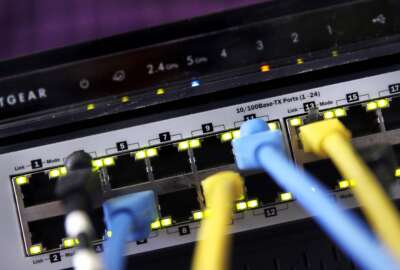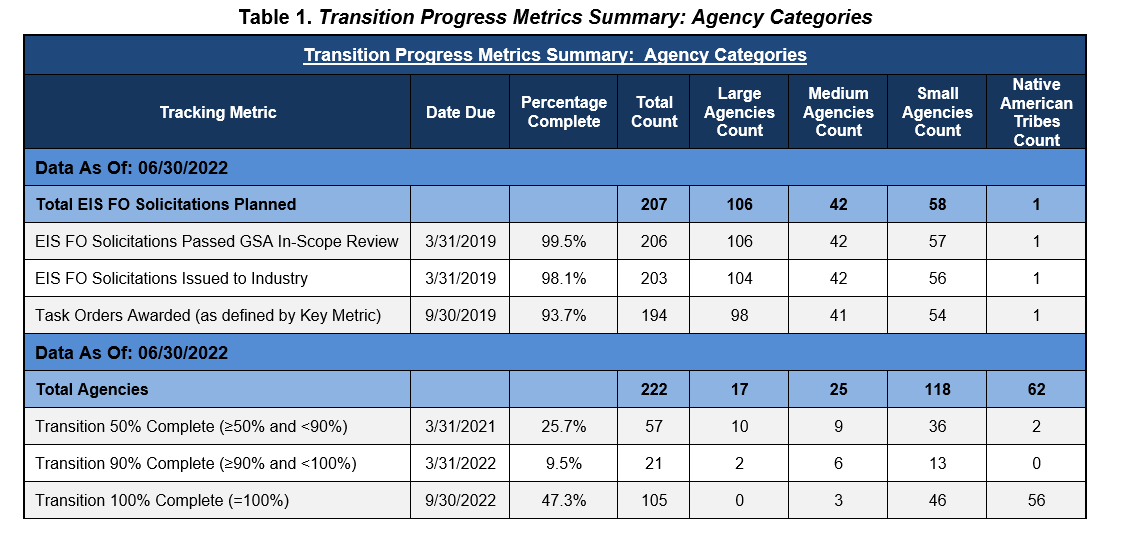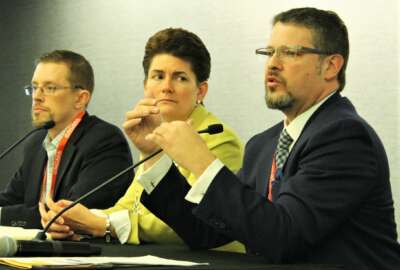 First Look
First Look  First Look
First Look USDA and NOAA are among the agencies that are taking advantage of the continuity of service agreements, giving them an extra year to complete their transition to...
.
Best listening experience is on Chrome, Firefox or Safari. Subscribe to Ask the CIO on Apple Podcasts or PodcastOne.
More than 100 agencies have signed on to extend their current set of telecommunications contracts for an additional year.
The General Services Administration gave agencies until Sept. 30 to sign a memorandum of understanding to keep using the Networx and other programs while they transition to the Enterprise Infrastructure Solutions or EIS program.
A GSA spokesperson said as of late August, 116 agencies have contacted GSA about signing the MOU, and of those, 48 have completed the process.
The spokesperson added there are five agencies that haven’t let GSA know about their plans and the agency plans to “redouble” their efforts with those five over the next month to ensure they can decide to sign the MOU or not.
“Next week we will again share that updated list with the contractors for their planning purposes,” the spokesperson said.
GSA said the transition has been slow for many agencies. Laura Stanton, the assistant commissioner for the Office of Information Technology Category (ITC), in GSA’s Federal Acquisition Service, wrote in an Aug. 23 blog that as of June 30, agencies have awarded 94% of all planned task orders.
“Also, 5.3 million of the 9 million legacy services governmentwide are still in use. These services range from telephone lines to high bandwidth secure internet access,” Stanton wrote. “We urge agencies to push toward completing 100 percent disconnection of services by Sept. 30, and assess their risk of not completing transition by May 30, 2023. Those who need more time to transition must sign a MOU to be authorized to use the continuity of service (CoS) period from June 1, 2023 to May 31, 2024.”
The overall disconnection rate as of July 29 was 62.8% governmentwide. GSA had set a 90% goal by March 31, 2022.

Stanton reminded agencies that if they don’t sign the MOU — so far just five agencies are on the spot as not having announced their intention, at least — GSA will remove them from the Networks Authorized User List (NAUL) for the expiring contracts. The contractors will then begin to disconnect the agency as early as November 2022 and complete it no later than May 2023.
GSA announced the plan for agencies to sign MOUs to take advantage of the CoS in February after it became clear that agencies would not meet the upcoming transition deadlines.
The Department of Agriculture and the National Oceanic and Atmospheric Administration are two agencies that plan to take advantage of the extended time to move to EIS.
Gary Washington, USDA’s chief information officer, said at a recent ACT-IAC webinar, while the transition is important, the focus is on ensuring USDA delivers better services to their customers and stakeholders and getting that right may make the transition to EIS take a little longer.
Of course, USDA was one of several agencies that faced a protest of their EIS award. Washington said the protest delayed USDA’s EIS efforts by about nine months.

“I don’t think [the protest] was the reason it’s taking longer than we hope. But it is going to be a change. For USDA, we want to take advantage of the advanced technologies that EIS has to offer, like software-defined wide-area network (SD-WAN) for an example,” Washington said. “In addition to that, the hybrid model we’re going to have is a partnership between the contractor and USDA. But we want to make sure that we have the expertise to manage this new model across USDA and be able to manage it as a consolidated environment. There’s going to be a lot of changed roles and responsibilities in terms of who’s responsible for what in our infrastructure as well. We’re really excited about that.”
While the National Oceanic and Atmospheric Administration didn’t face a protest of its EIS contract, Jeff Flick, the deputy director of the agency’s service delivery division, said they will take advantage of the CoS mainly because of the size of the transition effort they are facing.
“We’re dealing with a vendor count of about 260 between our GSA vendors and commercial vendors for just telecommunications. So from a scale perspective, EIS really provides an opportunity for us to consolidate that and that’s one of our primary objectives here is getting net down under, let’s say 10 vendors across our telecommunication spectrum,” he said. “How do we do that? We’ve let a contract. AT&T is our awarded vendor, but we have not progressed very far at this point.”
Flick said one of the biggest reasons for NOAA’s slow progress is the cost of running the current network, the cost of the transition and not having the appropriations to support both needs.
One agency that may not have to take advantage of the CoS is the Social Security Administration.
David Naugle, a senior IT specialist at SSA, said the agency was one of the first to award its EIS task orders. It chose MetTel in March 2020 under a 13-year, $253 million deal for voice services and Lumen in January 2020 under a 15-year, $470 million contract for data services.
In June, SSA had disconnected and transitioned about 66% of their circuits to EIS.
Naugle said these two deals will help consolidate more than 50 contracts and achieves cost savings or avoidance of more than $80 million annually on data services and another $20 million on voice services. He said in total, SSA would reduce costs by about 54% over what it had been spending.
“We had a lot of people doing their own thing, keeping an inventory on spreadsheets. It was all over the place. So going through that and centralizing our business processes from an ordering, invoicing and asset management perspective, that’s really helped us get a hold of what was in front of us. That was probably the biggest hurdle,” Naugle said. “Right now, we’re hitting our groove. I would say one of the biggest hurdles we have right now is this hybrid environment of transitioning to a new environment and still having some of our stuff on old contracts.”
GSA has made potential savings from EIS a central theme in its attempt to get agencies to accelerate their transitions.
By some estimates, agencies, on average, can save 25% on average comparing EIS to Networx. But at the same time, GSA says agencies will have access to more advanced capabilities like moving from a 40 gigabyte Ethernet connection to a 100G connection.
Flick said NOAA estimates its savings from transitioning to EIS to be about $10 million.
Washington added that USDA’s savings will come from consolidating 17 disparate networks, a long-time goal of his and many of his predecessors. The costs of the telecommunications services may not be that much lower, but USDA will get more and better capabilities, he said.
Copyright © 2025 Federal News Network. All rights reserved. This website is not intended for users located within the European Economic Area.
Jason Miller is executive editor of Federal News Network and directs news coverage on the people, policy and programs of the federal government.
Follow @jmillerWFED
 First Look
First Look 
